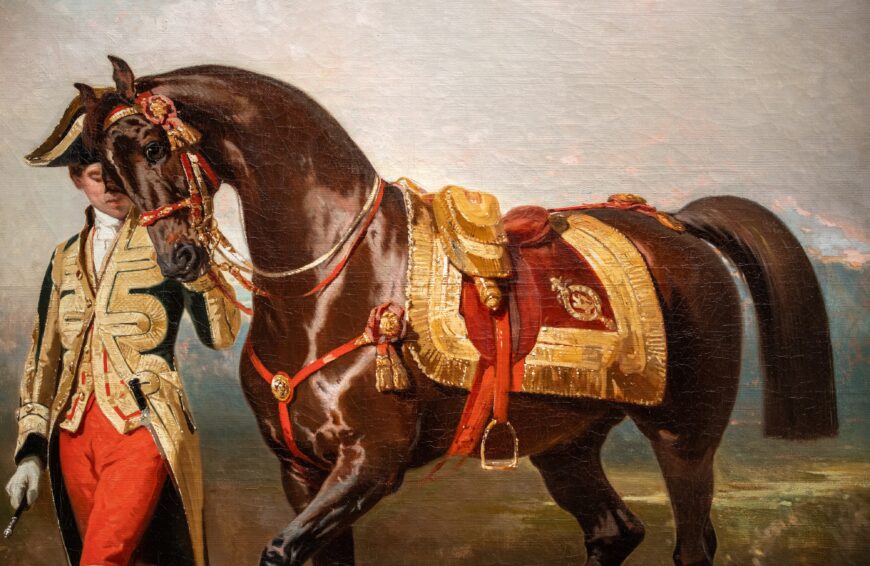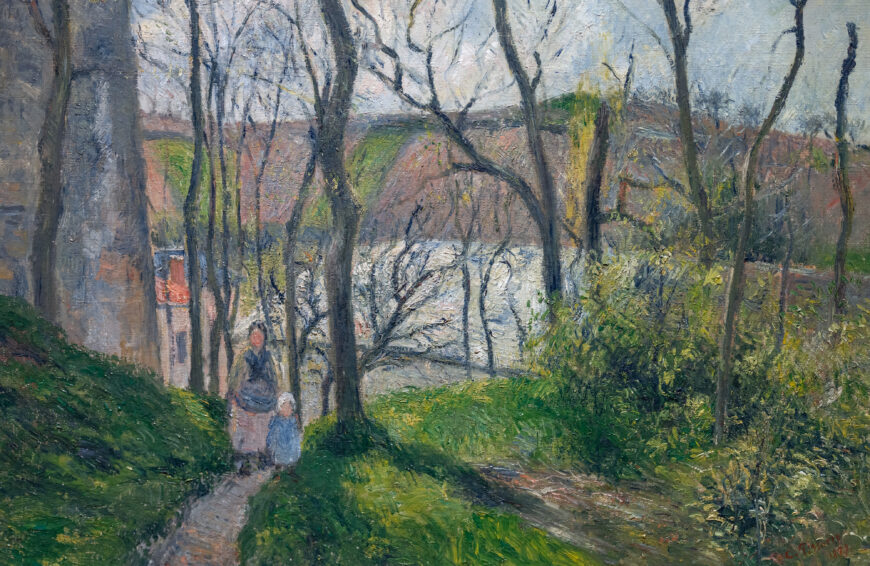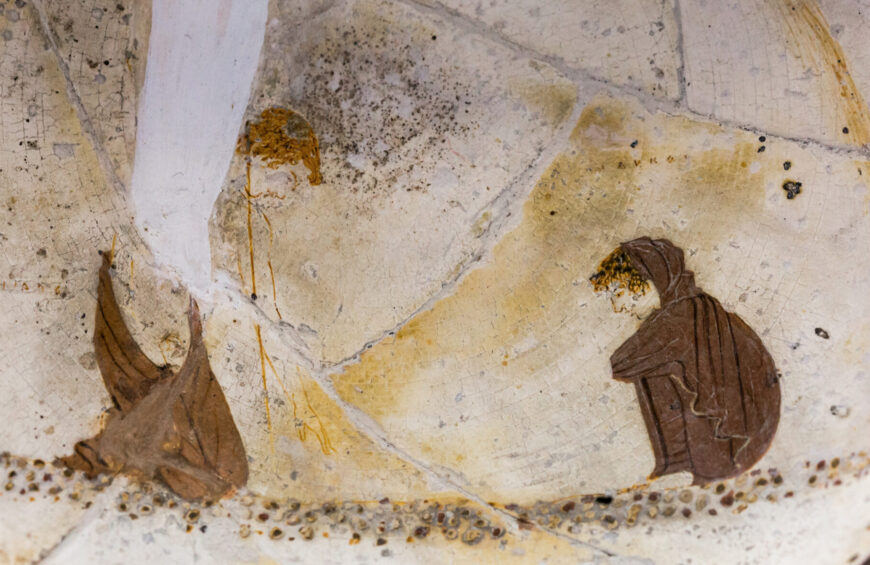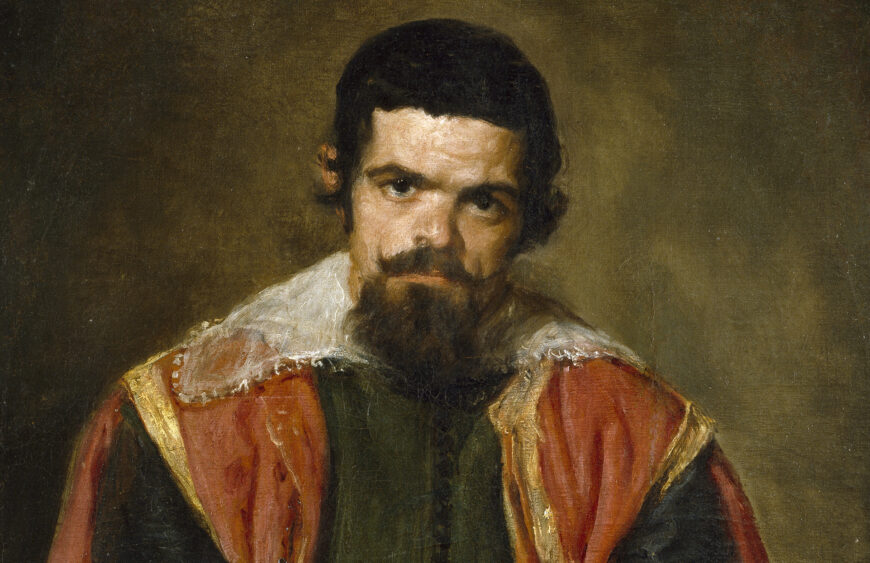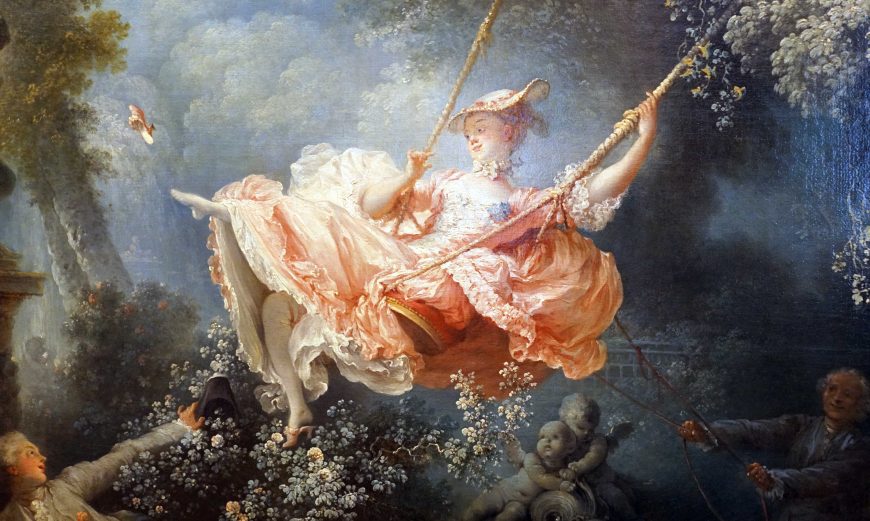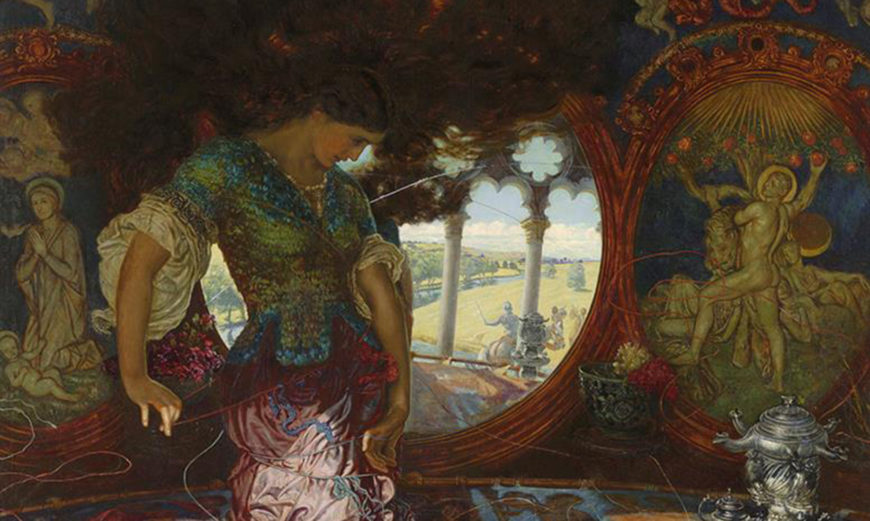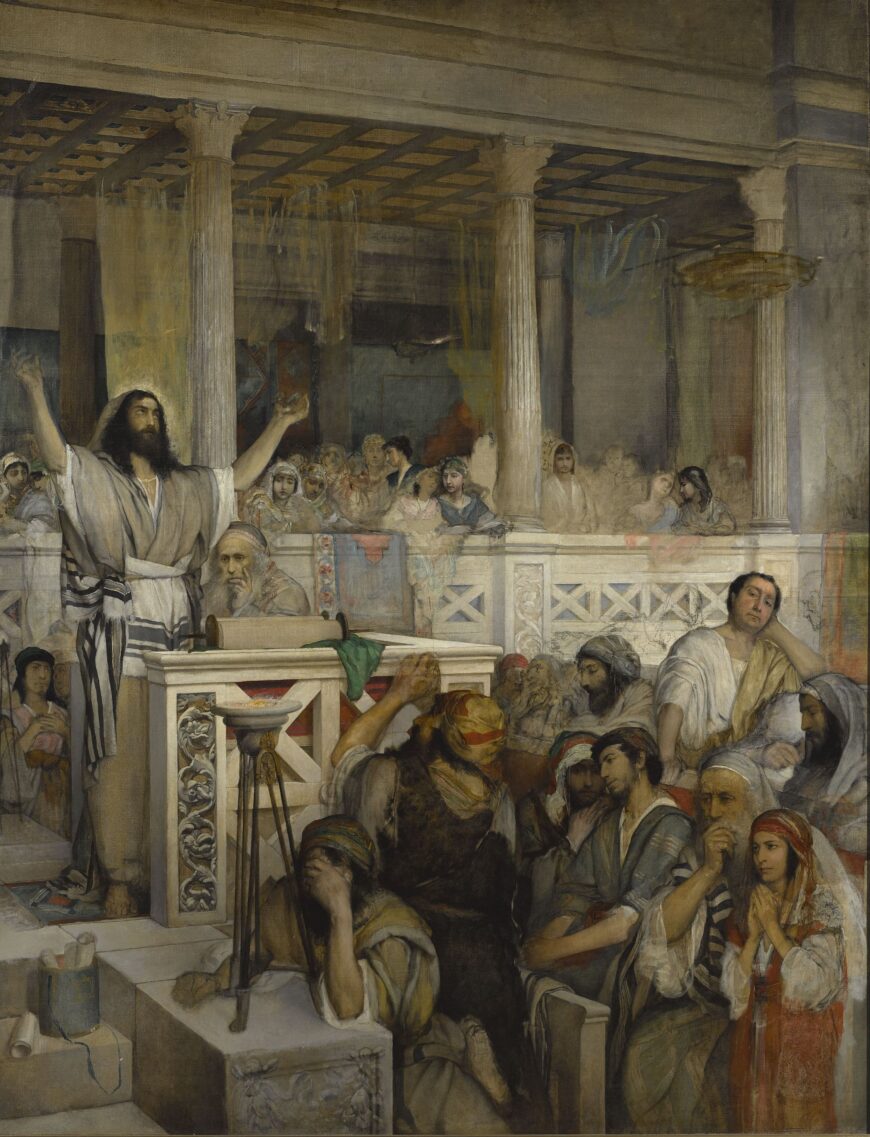
Maurycy Gottlieb, Christ Teaching at Capernaum, 1878–79, 209 x 271.5 cm (National Museum, Warsaw)
Near the end of his short life the Polish-Jewish artist Maurycy Gottlieb painted (but didn’t finish) a large biblical subject, Jesus Preaching at the Synagogue in Capernaum. In this scene from the New Testament the artist attempted to provide accurate details of the costume and architecture of biblical Palestine (period when the area was ruled by the Roman Empire). [1] In its naturalism, its anecdotal detail, and clear narrative, the painting accords with the later 19th-century academic history painting. At the right side, a Roman figure in a toga turns toward the viewer in seeming boredom, though he is surrounded by those in Middle Eastern garb listening attentively. Elements of ancient Roman culture abound, including a row of fluted columns with Corinthian capitals that support a coffered ceiling in the room behind Jesus.
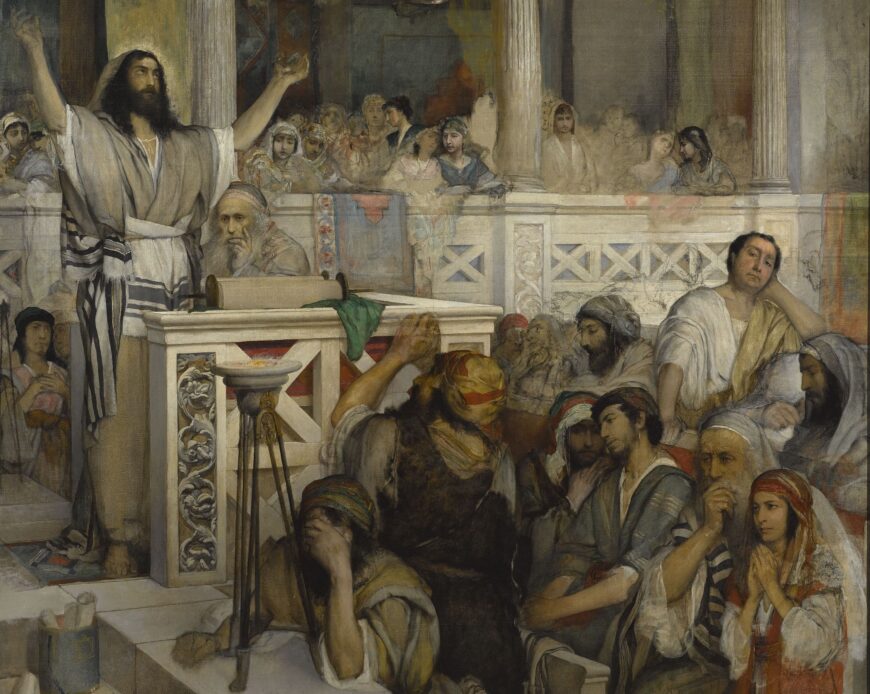
At the right, a Roman figure in a toga turns toward the viewer in seeming boredom, though he is surrounded by those in Middle Eastern garb listening to Jesus attentively. Detail, Maurycy Gottlieb, Christ Teaching at Capernaum, 1878–79, 209 x 271.5 cm (National Museum, Warsaw)
Jesus as a Jew
In addition to the Roman features, Gottlieb’s painting also adds distinctly Jewish elements, including the figure of Jesus himself, whom the artist expressly identifies as a practicing Jew. Jesus wears a tallit (prayer shawl) around his waist as he preaches with an open Torah scroll on the synagogue’s bimah (lectern). His sacred status is indicated by a halo’s golden glow. Gottlieb’s scene of Christ teaching addresses the dominant Catholic audience in his native Poland. As he declared in a letter to a friend from a trip to Rome in 1878, he wished for nothing more than harmony of his own Jewish people with their Catholic neighbors:
How deeply I wish to eradicate all the prejudices against my people! How avidly I desire to uproot the hatred enveloping the oppressed and tormented nation and to bring peace between the Poles and the Jews, for the history of both people is a chronicle of grief and anguish. [2]
In the painting, the congregation (except for the lone and seemingly bored Roman figure) is clearly Jewish. Many listeners wear prayer shawls (tallitot), some pulled over their brows. Jesus as a Jew is offering a sermon to his fellow Jews directly from their sacred Torah scroll, thus emphasizing the common roots that unify his mission with the biblical scripture of the Hebrew Bible. Their reactions are various, mostly serious but with varying degrees of intensity, ranging from the figure with hands uplifted in prayer to the moody introspection of his neighbor below the lamp, who covers his face in withdrawal or meditation. Also incorporating Jewish custom, Gottlieb shows a women’s gallery, isolated above and behind the main sanctuary.
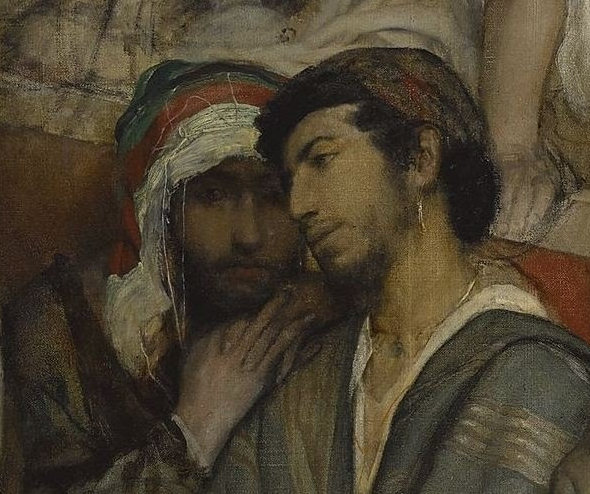
Detail, Maurycy Gottlieb, Christ Teaching at Capernaum, 1878–79, 209 x 271.5 cm (National Museum, Warsaw)
A self-portrait
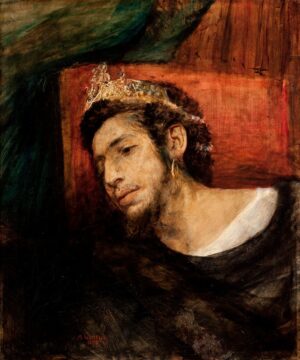
Maurycy Gottlieb, Ahasuerus (a self-portrait), 1876, oil on canvas, 63 x 53 cm (National Museum, Warsaw)
Significantly, Gottlieb also includes his own likeness within the congregation, listening to a companion with his head lowered. This self-image closely repeats one of his first self-portraits, where he shows himself in the guise of king Ahasuerus from the Book of Esther in the Hebrew Bible. These two heads not only share the same tilted pose and thoughtful expression but also share a prominent gold earring.
But why did the artist depict himself as King Ahasuerus—who reverses his genocidal plan for the Jews, only to act as their rescuer in his kingdom of ancient Persia? [3] Perhaps that openness by a gentle ruler allowed Gottlieb to imagine a political situation of acceptance and tolerance for Jews in Poland (more precisely in the region of Galicia).
For his own features, Gottlieb fashioned this close-up face in heavy shadows from direct exposure to the art of Rembrandt during his training at the Munich art academy.
Gottlieb and Rembrandt
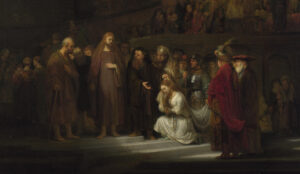
Detail, Rembrandt, The Woman Taken in Adultery,1644, oil on oak, 83.8 x 65.4 cm (The National Gallery, London)
Like Rembrandt’s own biblical scenes (such The Woman Taken in Adultery), Gottlieb portrayed a believably human, but also authentically Jewish Jesus. [4] In so doing, he followed other 19th century artists who turned decisively toward a human image of the historical Jesus. A major milestone was a Paris publication, Ernst Renan’s The Life of Jesus (1863). But during his Munich stay Gottlieb could also have accessed an eleven-volume History of the Jews (1856–76) by Heinrich Graetz, who emphasized Roman, secular responsibility for punishing Jesus rather than traditional Christian blame of the Jews, derived from the Gospels.
How would Gottlieb have known Rembrandt models for both portraits and history pictures beyond the few paintings available to him in Munich, Vienna, or Poland? Gottlieb benefited from the later 19th-century convergence of photolithographic reproduction technologies with an emerging art publishing industry, which together led to standardized series of illustrated art books devoted to the works of single, canonical masters. These books began to appear across Europe, and Rembrandt was among the first northern artists to be published. [5]

Aleksander Gierymski, Jewish Woman Selling Oranges, c. 1880–81, oil on canvas, 66 x 55 cm (National Museum, Warsaw)
During this period Polish painting (by artists such as Aleksander Gierymski and Piotr Michalowski) chiefly represented Jews as picturesque ghetto stereotypes. [6] So we can understand why the artist turned for inspiration to Rembrandt, who was then considered to have been a friend of the Jewish community in 17th-century Amsterdam. [7]
Jews in the Synagogue on Yom Kippur
In a more autobiographical mood, the painter famously represented Jews in the Synagogue on Yom Kippur. [8] Here we immediately recognize Gottlieb’s bearded self-portrait, posed at the same downcast angle in seeming meditation, but here he represented himself as a full-length figure, wearing a Jewish prayer garment (and eventual burial covering), called a kittel.

Maurycy Gottlieb, Jews Praying in the Synagogue on Yom Kippur, 1878, 243 x 190 cm (Tel Aviv Museum of Art)
Standing within his religious home, the artist is surrounded by tallit-garbed elders holding the Torah scroll and reading from prayerbooks at the lectern. Elsewhere a pair of boys (whom some viewers have speculated might be youthful self-portraits) fill out the space, while the women’s gallery above seems to contain one or more portraits (also arousing speculation). Certainly, both the self-portrait and the woman looking out at the viewer above him reveal a talent for portraiture that Gottlieb also practiced during his brief career. Yet here Gottlieb already seems wistfully aware of his own death. On the mantle of the Torah scroll he wrote an inscription in Hebrew that suggests a foreknowledge of his early death: “Donated in memory of the late honored teacher and rabbi Moshe Gottlieb of blessed memory 1878.”
About the artist
Maurycy Gottlieb was born in Lemberg (Lviv in modern Ukraine) and strove during his productive but brief career to establish his Jewish identity in his art. [9] But Gottlieb also strove to incorporate his Polish identity in his art, studying under Poland’s leading history painter, Jan Matejko, at the Cracow Academy. Gottlieb worked principally in Galicia, chiefly Cracow, where he is buried, but he also studied and later worked in Vienna. His trips included stays in both Budapest and Rome.
Despite his premature death, Maurycy Gottlieb successfully grafted his Jewish roots onto the dominant academic art forms of Central Europe and provided pioneering inspiration for his artistic co-religionists, led by Samuel Hirszenberg, to follow.



